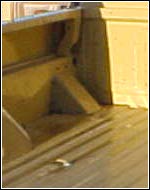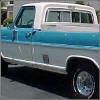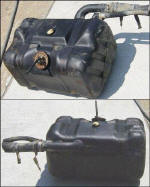|


|

|
|
|
Fuel
Tank Discussion and Options |
|
|
 |
|
|
|

The notorious in-cab tank. The standard version holds 19 gallons,
those equipped with evap. controls hold 18.5 gallons. A
21.5-gallon version was also available. |
One of the most frequently-asked questions from owners of older Ford
pickups is "How do I remove the in-cab fuel tank and install a
replacement under the bed?" Some people simply want to gain some
additional storage inside, others want to install sound system
equipment, like a subwoofer. And some just simply feel unsafe with the
fuel tank inside the cab, wondering about the possible consequences in
the event of a serious collision. (To those people I have a response: If
you get into a serious enough collision where the cab AND the fuel tank
is breached, you're probably not going to be alive to worry about the possibility
of fire!)
However, a valid reason for wanting to relocate the tank involves gas
fumes inside the cab. If the filler neck grommet isn't completely sealed
against the cab wall, any drippage when refueling will seep into the
cab, and the fumes make driving the truck unpleasant. This problem can
be solved by replacing the fuel filler neck grommet and fuel cap, to
ensure proper sealing.
However, if you're set on removing the in-cab tank, for whatever reason, you have
several options available. Let's first take a moment and review the
various styles of optional fuel tanks available either from the factory
or installed by the local Ford dealer. |
|
The easiest by far is to find a '67-'72 Ford pickup equipped with the
Camper Special (CS) option...though they were an available option on all
trucks, so don't limit your salvage-yard search. Most of these trucks came with
an auxiliary
fuel tank which was mounted between the frame rails under the cab and
bed. These tanks are filled from the side, with '67-'69 trucks having a
filler neck located above the beltline, while the '70-'72 trucks have
the filler neck below the beltline. If you're fortunate enough to
find a CS in a salvage yard, be sure to grab all the hardware, including
the tank, filler neck, lines, cross-frame bracket, fuel tank straps, skid plate
and in-bed fuel filler neck cover (Fig. 1). Installing
this tank will require cutting a hole in the side of the bed and another
hole in the bed floor to install the filler neck. |
 |
Fig. 1
- The in-bed fuel filler neck
cover on '67-'69 models.
Fig. 2
- The in-bed fuel filler neck
cover on '70-'72 models.
|
 |

Fig. 3
- This is the hole cut into the pickup bed's floor to accommodate
a factory auxiliary fuel tank filler neck. (Click to enlarge) |
 |
Fig. 4
- On the left is the factory auxiliary fuel filler neck location on
'67-'69 pickups. The '70-'72 trucks had the filler neck located below
the beltline (pictured on the right). |
|

Fig. 11

Fig. 12 |
|

Fig. 13 |
Here is one variety of a truck equipped with dealer-installed steel
auxiliary tanks. If equipped with a single tank, such as on Camper
Specials with the built-in toolbox in the side of the bed, the tank will
be mounted on the driver's side. Trucks without the built-in toolbox
might have dual tanks. This style can be easily spotted by their lightweight aluminum doors mounted on
the fender exterior.
These tanks hang from the bottom of the bed outside the frame with long
bolts and retaining straps. They are not equipped with sending units, so
they are unsuitable for use as primary tanks without some additional
work to add one. Fig. 13 (above) shows one of these styles being removed
from a '72 Camper Special. The wooden slat on the ground beside the tank
is one of several used as insulators between the tank and the bed. You
can also see the notch towards the rear of this tank which is necessary
to clear the leaf spring mounting bracket. |
|

Fig. 17 - This '69 Highboy has the '73-'77 highboy auxiliary tank
installed. Note the rear fuel door and the lack of fuel
filler opening on the cab...looks good! |
Another factory option for an auxiliary fuel tank which can be used as a
bolt-on for the '67-'72 era of Ford pickups actually was an option
during the '73-'79 era. Because the rear frame rails (from the rear of
the cab on back) on the '73-'79 2WD trucks are 4" wider than the
previous generation, the standard rear-mounted fuel tanks cannot be
used. However, the '73-'77-1/2 4WD truck's frames were NOT wider....they are the
same width as the '67-'72 generation and will fit the earlier trucks
perfectly. These highboys still used the
in-cab tank, but a plastic 20-gallon auxiliary tank was available which
fit between the rear frame rails. It was filled from the side, so an
access door would have to be fabricated on the bed side for refueling
(see Fig. 17). |

Fig. 18 - This plastic auxiliary
fuel tank measures approximately 27" x 17" x 15". |
|
|
 |

Want to link to
this site? Please save this banner to your hard drive to place on your
webpage.
The correct link to use is
http://www.fordification.com
|